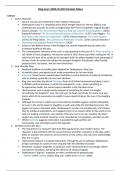King Lear (1605/6) AO3 Context Notes
Literary
1. Source Materials
Several sources were important in the creation of King Lear
Shakespeare’s play is a composite piece which merges historical, literary, Biblical, and
contemporary accounts to create an original play (the Fool is completely original though)
Sources include: ‘The True Chronicle History of King Leir, and His Three Daughters’ (1605),
Raphael Holinshed ‘The First and Second Volumes of Chronicles’ (1587), John Higgins ‘The
First Parte of the Mirour for Magistrates’ (1574), Edmund Spenser ‘The Faerie Queene’
(1596), Sir Philip Sidney ‘The Countesse of Pembrokes Arcadia’ (1590), Samuel Harsnett ‘A
Declaration of Egregious Popish Impostures’ (1603)
Echoes of the Biblical stories of the Prodigal Son and the longsuffering Job add to the
archetypal quality of the play
The contemporary relevance of the story is also apparent in the case of Sir Brian Annesley, a
rich father of three daughters. He became senile in 1603, three years after making his will, in
which he left most of his wealth to his youngest child. His eldest daughter took advantage of
his loss of wits to contest the will but his youngest daughter, fortuitously called Cordell,
protected him, his wishes, and her own inheritance
2. Early Morality Plays
Medieval tradition of morality plays adapted for Shakespeare’s King Lear
In morality plays, protagonist must make preparations for his own death
Everyman (most famous morality play) illustrates a central doctrine of medieval Christianity:
only by leading a good life can you earn salvation.
King Lear wrenches the plot of Everyman from its Christian framework and plays it out in
a nihilistic spiritual universe, in which the protagonist—Lear—loses everything as
he approaches death, but cannot expect salvation in the Christian sense.
Like Everyman, Lear is progressively stripped of everything he values: his knights,
his authority, his daughters’ care, the roof over his head, and finally his sanity. Lear also
learns which of his possessions he ought to have valued all along: the love of his daughter
Cordelia.
Although the scenes in which Lear is reconciled to Cordelia suggest a partial redemption
for Lear, in the end he loses his daughter as well, and unlike the Christian Everyman, the
pagan Lear goes to his death alone. Shakespeare’s version of a morality play is far bleaker
than its medieval antecedents, as it suggests there is no reward, either in this world or the
next, for leading a moral life. Lear repents of his sins, but to no use. Cordelia, the play’s
single truly moral and kind character, is not rewarded for her goodness, and dies as well.
While Everyman suggests redemption is possible through sacrifice and
moral purity, Lear seemingly asserts the opposite.
3. Jacobean Drama/the big 4
The malcontent is a character type that often appeared in early modern drama. The
character is discontented with the social structure and other characters in the play, and is
often an outsider who observes and comments on the action, and may even acknowledge
they are in a play.
‘Edmund the bastard’ is a typical malcontent. Through his use of soliloquy, Shakespeare
brings us perhaps to a point of near empathy with this deceitful character.
Elsewhere, Jacobean tragedies, in particular, were characterised by increasingly violent
and extreme situations, betraying the influence of classical tragedy.
Shakespeare’s ‘big four’ tragedies are often considered his greatest plays
– Hamlet (1599), Othello (1603), King Lear (1606) and Macbeth (1606).




